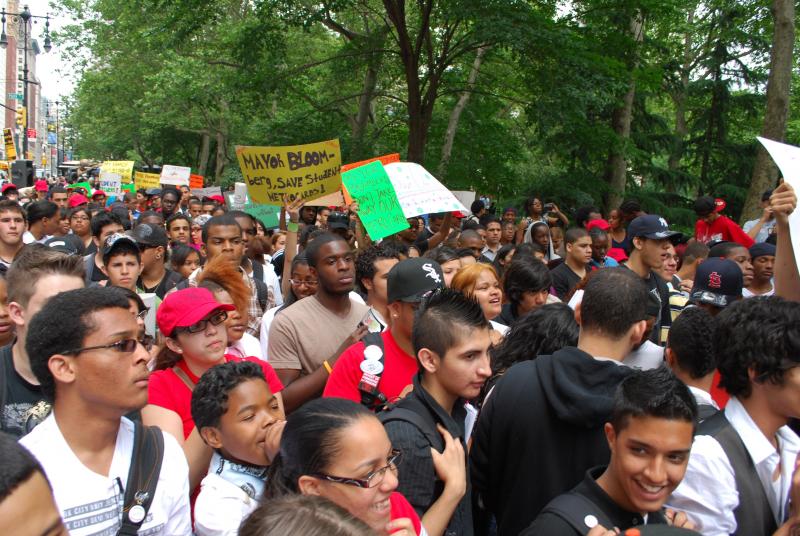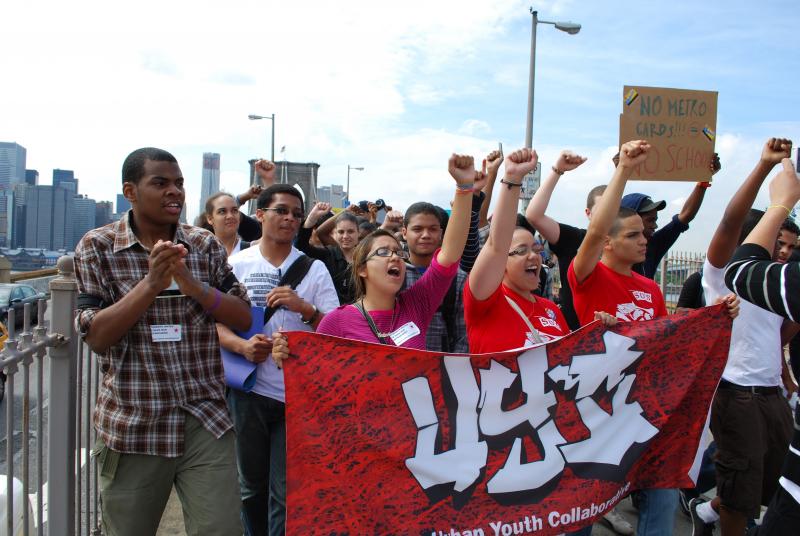Photos by Jason Masten
When budget cuts threatened the program that provides transportation for New York City schoolchildren, Urban Youth Collaborative organized students to fight back.

Without the student MetroCard program, which provides free public transportation to and from school, New York City K–12 students living in zones where the schools are severely overcrowded and under-resourced would not be able to travel to schools that offer them better opportunities to succeed and go to college. Dropout rates are already staggering: Only 36 percent of students who enter high school in the Bronx graduate. In addition, cutting the student MetroCard program would result in an increase in crime rates among youth because they would have to resort to jumping the turnstiles. Cutting the MetroCards would lead to an even more segregated New York City (which is already one of the most segregated cities in the country) because students wouldn’t be able to leave their own boroughs.
For more than half a century, the city and state of New York have provided free fares to students who needed to travel to and from school. In 1994, Mayor Rudy Giualiani said that the city would stop paying its share of the cost because it should be the MTA’s sole responsibility. This forced the MTA to sign a Memorandum of Understanding in 1995 that made the funding of student fares a three-way responsibility: the city, the state, and the MTA would each pay $45 million.
Recently, however, instead of spending money to keep services and school MetroCards, the MTA has been investing in big projects like the $1.4 billion Fulton Transit Center, while the city chooses to invest in metal detectors and more cops in schools. In September 2009, Governor David Paterson slashed the state’s funding for MetroCards from $45 million to $6 million. Soon after, the MTA announced that it would be eliminating the program by 2011 due to a budget deficit of almost $800 million. This meant that families would have to pay almost $1,000 per child to send them to school. Eliminating the cards would affect the more than 600,000 students who use the cards to get to school each day. The impact would have hit low-income families of color the hardest. Parents who live paycheck to paycheck struggling just to pay their rent would have to provide each child with $4.50 a day to go to school.
Understanding that working-class families from every borough in New York City would not be able to afford to send their kids to school, the Urban Youth Collaborative (UYC) held its December 2009 student union meeting, attended by 150 students. There, members decided on the campaign to save student MetroCards. The group represented students from four boroughs, more than 20 schools, and students of color. They renamed themselves Students for Transportation Justice (STJ).

In the beginning stages of our campaign, the UYC/STJ held numerous press conferences and rallies of hundreds of high school students outside the MTA offices, where members of the City Council (including Speaker Christine Quinn), members of the Transit Workers Union, and student leaders spoke. Understanding that the MTA alone could not solve the MetroCard crisis and that those responsible did not understand what this would mean for our families, student leaders drafted letters requesting to meet with Mayor Michael Bloomberg, Governor Paterson, and MTA Chairman Jay Walder.
Our initial letters to their offices went unanswered, so we held a rally outside City Hall and hand-delivered the letter to the mayor’s office. A student handed the letter to the chairman at an MTA Board meeting in February 2009. When they still did not respond, the UYC/STJ mobilized hundreds of students to attend all the MTA public hearings on service cuts. At the Manhattan hearing, we confronted the chairman while he sat on stage and got him to publicly accept a meeting with the students!
After that, we were able to meet with city officials from the mayor’s office and the City Council. The students came to their meeting with Chairman Walder with a list of demands and negotiated a temporary stop to cutting the MetroCard program until after the city and state budgets were released. Riding this momentum, we mobilized 50 parents and students to go to Albany and speak with more than 25 state legislators.
After months of rallying, talking, and organizing and as the deadline to save the fares was approaching with no clear sign that those in power were going to save our MetroCards, something needed to be done. We organized a student-led walkout of 23 high schools in New York City within two weeks. More than 1,000 students walked out of their schools to a rally at City Hall Park. There, student leaders spoke alongside City Council members, Transit Worker Union members, CUNY professors, and parents. The mayor even gave us a “shout out” on his morning radio show and said we were “being cute.” After the rally, we marched over the Brooklyn Bridge to MTA headquarters in Brooklyn.
Although there were a few negative responses from the media and the city administration about our walkout, the message was “heard loud and clear,” according to the MTA heads. And they weren’t the only ones who heard the voices of the youth. On June 18, 2010, the New York State Assembly agreed to pay $25 million (down from the original $45 million) toward the cost of the MetroCards, the city agreed to continue paying $45 million, and the MTA agreed to pick up the rest of the tab (an estimated $144–200 million), prompting the MTA to announce that it would not cut the MetroCards for the upcoming school year. This was a major victory for the students of New York and the youth organizers who ran a campaign they were told they couldn’t win.
The MTA is still facing huge budget deficits with no solutions in sight. This means that, while our victory has secured the free transportation for students for this school year, we could easily see ourselves starting the fight all over again next year to save our MetroCards.



